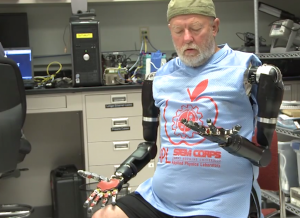
While others have been able to control robotic limbs with their minds, the technique is new enough that dual-control has never been tried before.
Credit: Johns Hopkins
History was made when the first bilateral shoulder-level amputee was able to wear and simultaneously control two prosthetic limbs. The amazing part? He was able to operate the system by simply thinking about moving his limbs.
The groundbreaking event took place at Johns Hopkins Applied Physics Laboratory, where they’ve been working to develop Modular Prosthetic Limbs as part of the Revolutionizing Prosthetics Program over the past decade.
Les Baugh was the man who made the limbs come to life. Baugh lost both arms in an electrical accident 40 years ago and until now, did not think having two functional, mind-controlled prosthetic limbs was in the realm of possibility.
“We use pattern recognition algorithms to identify individual muscles that are contracting, how well they communicate with each other, and their amplitude and frequency,” Johns Hopkins Trauma Surgeon Albert Chi explained. “We take that information and translate that into actual movements within a prosthetic.”
The team built a custom socket for Baugh’s torso and shoulders to support the prosthetic limbs and make neurological connections with the reinnervated nerves. Then, the team had Baugh work with the limb system though a Virtual Integration Environment (VIE).
This from Johns Hopkins Applied Physics Laboratory:
The VIE is completely interchangeable with the prosthetic limbs and through APL’s licensing process currently provides 19 groups in the research community with a low-cost means of testing brain–computer interfaces. It’s being used to test novel neural interface methods and study phantom limb pain, and serves as a portable training system.
The next stop is to send Baugh home with a set of the limbs to see how they function in day-to-day life.
Scientist are making phenomenal advancements in prosthesis every day. Find out what the ECS scientists are doing in the field of prosthetic limbs via the Digital Library.
And don’t forget to sign up for our free e-Alerts, which will notify you when new publications and manuscripts are available.

